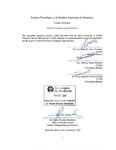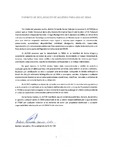| dc.contributor.advisor | Garza, Luis Eduardo | |
| dc.creator | García, Andrés | |
| dc.creator | 891216 | |
| dc.date.accessioned | 2020-03-14T01:26:48Z | |
| dc.date.available | 2020-03-14T01:26:48Z | |
| dc.date.created | 2019 | |
| dc.identifier.citation | García, A. (2019). Bioinspired Search and location of Air Pollutant Sources based on a Bayesian Heuristic + Dragonfly Algorithm (Master's degree). Tecnologico de Monterrey , Monterrey, N.L. | es_MX |
| dc.identifier.uri | http://hdl.handle.net/11285/636277 | |
| dc.description.abstract | In nature there are many types of interaction between individuals. These behaviors have been optimized in millions of years and their main objective is the survival of the species. The objective of interacting with other individuals is to solve difficult problems, problems that a single individual would solve inefficiently. The problem aborted by this thesis is the search for and location of air pollutant sources. A SO2 plume is simulated and placed in a region to perform the search. To collect contaminant samples, the dynamics of 2 unmanned aerial vehicles are simulated. The algorithm runs under a real-time simulation environment. A 2-dimensional Hammersley sequence is used in an exploration stage. Clustering by Kmeans and a Greedy Search are also used to solve the Travelling Salesman Problem at the Hammersley points. In this first stage an attempt is made to find a measure of the concentration of air pollutants that exceeds a certain threshold. In an exploitation stage, the Unmanned Aerial Vehicles (UAVs) will track the source approaching this point. A probability map is used to modify the behavior of the Dragonfly Optimization Algorithm. The probabilistic map acts as the heuristic of the system to locate the source of air pollution. To check the efficiency of the proposed strategy it is compared with 3 other algorithms: Greedy Search, Greedy Search with cooperation and the Dragonfly Algorithm without modifications. All these approaches are tested in the same simulated environment, without obstacles for UAVs. Efficiency is measured with respect to the maximum level of concentration of contaminants found, the distance to the source of contamination, the time taken to find the maximum concentration of contaminants and the UAVs path until that time. Finally, a one-factor ANOVA is performed to check that the responses are statistically better. | es_MX |
| dc.publisher | Instituto Tecnológico y de Estudios Superiores de Monterrey | esp |
| dc.relation.isFormatOf | versión publicada | es_MX |
| dc.rights | Embargoed Access | es_MX |
| dc.rights.uri | http://creativecommons.org/licenses/by-nc-sa/4.0/ | * |
| dc.subject | INGENIERÍA Y TECNOLOGÍA | es_MX |
| dc.subject.lcsh | Science | es_MX |
| dc.title | Bioinspired Search and location of Air Pollutant Sources based on a Bayesian Heuristic + Dragonfly Algorithm | es_MX |
| dc.type | Trabajo de grado, Licenciatura / bachelor Degree Work | es_MX |
| dc.contributor.committeemember | Vargas, Adriana | |
| dc.contributor.committeemember | Sotelo, David | |
| dc.publisher.institution | Instituto Tecnológico y de Estudios Superiores de Monterrey | es_MX |
| dc.subject.keyword | Heuristic | es_MX |
| dc.subject.keyword | Cooperative Search | es_MX |
| dc.subject.keyword | Probability map | es_MX |
| dc.contributor.institution | Campus Monterrey | es_MX |
| dc.contributor.institution | Campus Monterrey | es_MX |
| dc.contributor.institution | Campus Monterrey | es_MX |
| dc.description.degree | Maestría en ciencias de la ingeniería | es_MX |
| dc.relation.impreso | 2019-12-09 | |




